英汉汉英视译教程序言
- 格式:pdf
- 大小:3.83 MB
- 文档页数:20
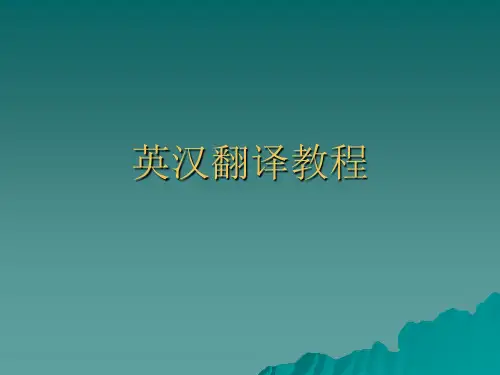
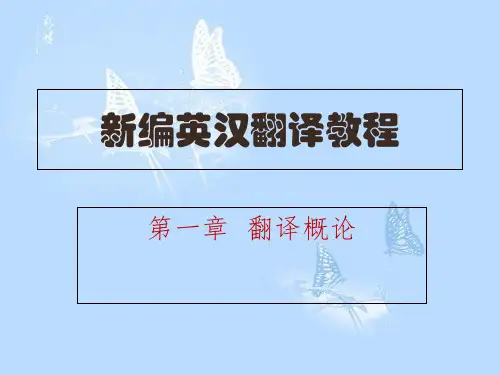
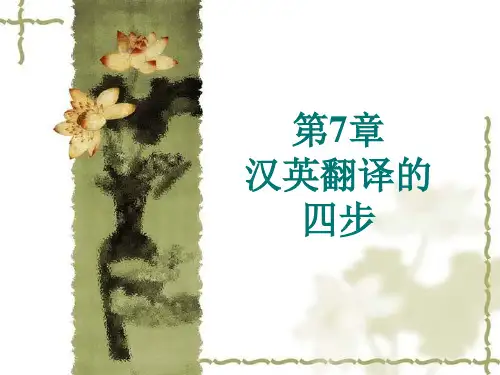
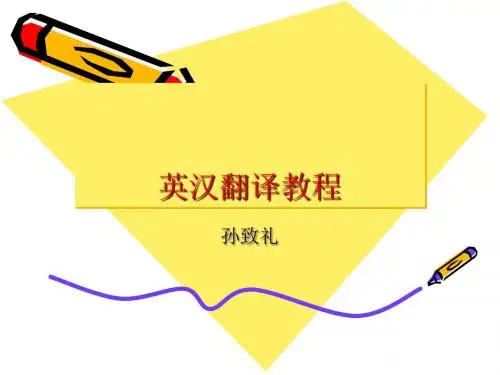
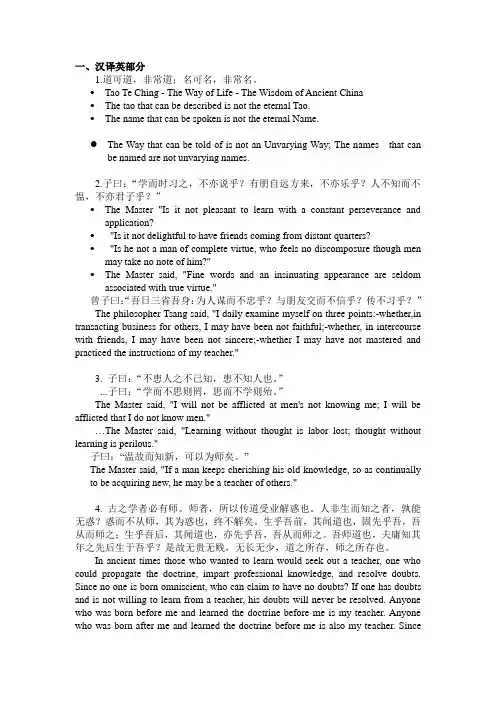
一、汉译英部分1.道可道,非常道;名可名,非常名。
•Tao Te Ching - The Way of Life - The Wisdom of Ancient China•The tao that can be described is not the eternal Tao.•The name that can be spoken is not the eternal Name.The Way that can be told of is not an Unvarying Way; The names that can be named are not unvarying names.2.子曰:“学而时习之,不亦说乎?有朋自远方来,不亦乐乎?人不知而不愠,不亦君子乎?”•The Master "Is it not pleasant to learn with a constant perseverance and application?•"Is it not delightful to have friends coming from distant quarters?•"Is he not a man of complete virtue, who feels no discomposure though men may take no note of him?"•The Master said, "Fine words and an insinuating appearance are seldom associated with true virtue."曾子曰:“吾日三省吾身:为人谋而不忠乎?与朋友交而不信乎?传不习乎?”The philosopher Tsang said, "I daily examine myself on three points:-whether,in transacting business for others, I may have been not faithful;-whether, in intercourse with friends, I may have been not sincere;-whether I may have not mastered and practiced the instructions of my teacher."3. 子曰:“不患人之不己知,患不知人也。
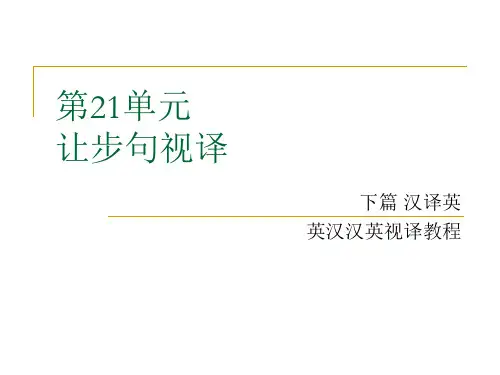
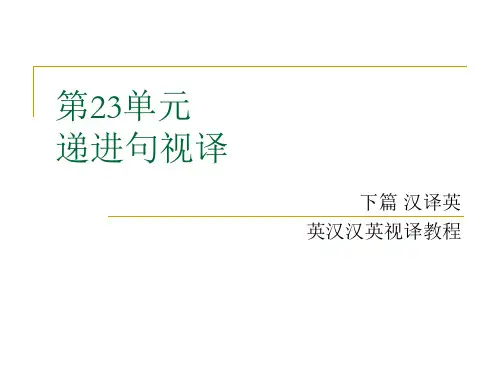
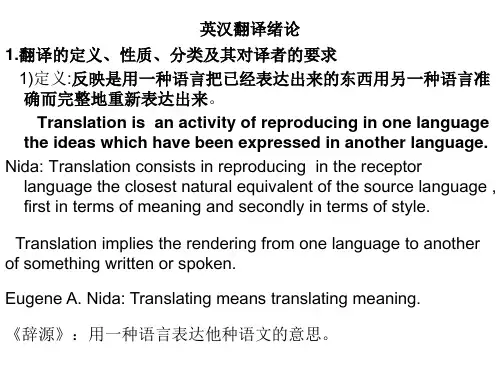
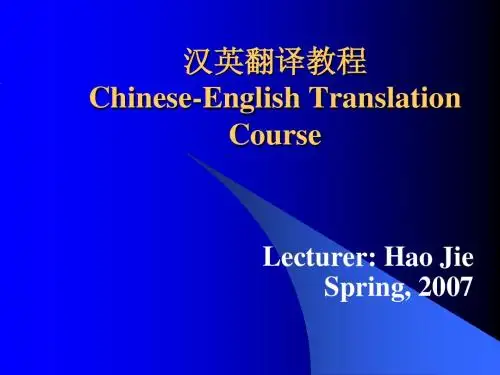
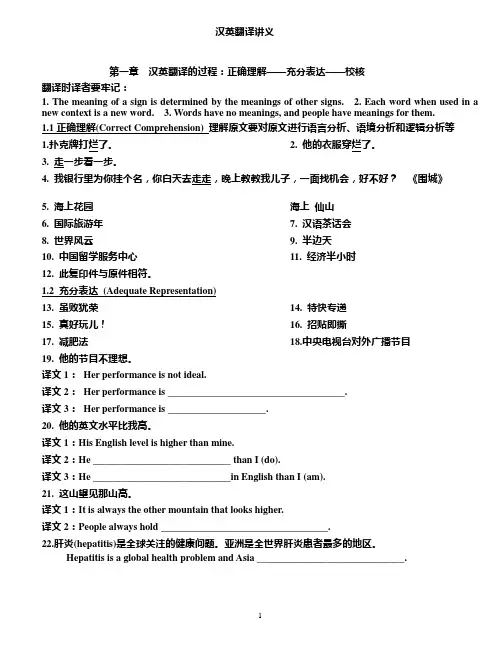
汉英翻译讲义第一章汉英翻译的过程:正确理解——充分表达——校核翻译时译者要牢记:1. The meaning of a sign is determined by the meanings of other signs.2. Each word when used in a new context is a new word.3. Words have no meanings, and people have meanings for them.1.1正确理解(Correct Comprehension) 理解原文要对原文进行语言分析、语境分析和逻辑分析等1.扑克牌打烂了。
2. 他的衣服穿烂了。
3. 走一步看一步。
4. 我银行里为你挂个名,你白天去走走,晚上教教我儿子,一面找机会,好不好?《围城》5. 海上花园海上仙山6. 国际旅游年7. 汉语茶话会8. 世界风云9. 半边天10. 中国留学服务中心11. 经济半小时12. 此复印件与原件相符。
1.2 充分表达(Adequate Representation)13. 虽败犹荣14. 特快专递15. 真好玩儿!16. 招贴即撕17. 减肥法18.中央电视台对外广播节目19. 他的节目不理想。
译文1:Her performance is not ideal.译文2:Her performance is ____________________________________.译文3:Her performance is ____________________.20. 他的英文水平比我高。
译文1:His English level is higher than mine.译文2:He ____________________________ than I (do).译文3:He ____________________________in English than I (am).21. 这山望见那山高。

新编汉英翻译教程详解第一章绪论1.1 翻译的性质和分类1. 翻译的定义:翻译是将一种语言文化承载的意义转换到另一种语言文化中的跨语言、跨文化的交际活动。
翻译的本质是释义,是意义的转换。
2. 翻译的分类:按文本而言,分为文学翻译、科级翻译、应用文翻译就方式而言,分为全译、摘译、编译。
全译:全文照译,全译是翻译的最基本方式,它是翻译的基础。
摘译:根据特定目的的摘取、翻译原文中的部分内用,以利译文读者更方便,更快捷的获取原文文献主要信息的方式。
编译:则是“编辑”和“”翻译的结合。
3.翻译活动涉及的因素:译者:translator, 作者:author, 原文: source text,原文读者: source-text readers译文:target text/translated text/target version, 译文读者: target-text readers1.2 汉英翻译的单位----句子句子:句子是用词或词组构成的一个能够表达一个完整意思的语言单位。
每个句子都有一定的语调,表示陈述、疑问、祈使、感叹等语气。
在连续说话时,句子和句子中间有一个较大的停顿。
在书面上,句子的停顿处,要根据不同的语调分别用句号、问号火感叹号。
(定义来自《汉语大辞典》)从意义上讲,句子能够表示一个完整的意思从功能上讲,句子表示陈述、疑问、祈使、感叹等语气从形态上讲,句末有句号、问号或感叹号为标志因此,句子是较为理想的翻译单位。
1.3 汉英翻译的标准1.严复的标准信:faithfulness 指准确的传达原文的内容,即信于读者和作者,不允许对原作有任何歪曲或篡改,译作不容许有任何遗漏和省略。
达:expressiveness 指译文使用标准汉语,即译文语言应通俗明白,不应模棱两可,晦涩难懂,不滥用陈词滥调,繁文缛句,也不应有粗枝大叶的错误雅:elegance 指译文的美学价值,它体现在修辞、文体、韵律、诗意和心理等五个方面2. 刘重德的标准信:faithfulness 信于原文内容to be faithful to the content of the original达:expressiveness 具备原为一样的表现力to be as expressive as the original切: closeness 尽可能的切近原文的风格to be as close to the original style as possible3. 泰勒的西方翻译标准译文应该完全传达原文的思想 a translation should give a complete transcript of the ideas of the original work译文的风格和笔调应与原文一致the style and manner of writing should be of the same character as that of the original 译文应像原文一样流畅 a translation should have all the ease of the original compositon4. 张陪基的标准—使用语初学者忠实:faithfulness, 忠实于原作的内容和风格通顺:smoothness, 译文语言必须通俗易懂,符合规范5.本书的标准功能相似,语义相符,similarity in funciton and correspondence in meaning6. 语言的功能A, 信息功能:informative function =所指功能:referential function, 它是语言传达信息,影响他人认知的功能B. 表情功能: expressive function, 它是语言表达言者或作何,即言语始发者的思想感情的功能。
新世纪大学英汉翻译教程__上海交大毛荣贵教...一.英汉翻译理论与实践课程之教案目录第1讲“翻译”溯源第2讲翻译的本质第3讲翻译的标准第4讲翻译面面观第5讲翻译必有“失”/失于此而得于彼(两讲合并)第6讲翻译与联想第7讲翻译与语法第8讲翻译与语体第9讲翻译与语篇第10讲英汉十大差异第11讲形合与意合第12讲代词的困惑第13讲Connotation的翻译第14讲翻译与词典第15讲以“模糊”求精确第16讲落笔知轻重译文讲分寸第17讲翻译最难是口吻第18讲翻译与形象思维第19讲翻译与灵感思维第20讲英语修辞的翻译(包括连接三讲)第21讲翻译中的文化冲击第22讲思维是语言的脊梁(两讲合并)第23讲翻译美学之思考(两讲合并)二.汉英翻译理论与实践课程之教案目录第1讲汉译英呼唤文字功力第2讲语篇与翻译第3讲:英汉语美感比读(两讲合并)第4讲:理性概译:翻译之坦途第5讲:英语句式的亮点:非人称主语句(两讲合并)第6讲:汉译英有用的句型(两讲合并)第7讲:类析汉译英常见拙译(三讲合并)第8讲:从“湖光山色”的英译说开去(两讲合并)第9讲:Denotation和Connotation(两讲合并)第10讲:翻译,你的本质是什么?第11讲:归化与异化----汉语习语的英译一.英汉翻译理论与实践课程之练习第1讲“翻译”溯源试将下列文字译成汉语:1/Translation consists in reproducing in the receptor language the closest natural equivalent of the source language,first in terms of meaning and secondly in terms of style.(Eugene A.Nida& Charles R.Taber:The Theory and Practice of Translation,1969)2/Translation may be defined as follows:The replacement of textual material in one language(SL)by equivalent textual material in another language(TL)3/A translation should give a complete transcript of the ideas of the original work.The style and manner of writing should be of the same character as that of the original.A translation should have all the ease of the original composition.(A.F.Tytler:Essay on the Principles of Translation.1791)参考译文1/所谓翻译,是在译语中用最切近的自然的对等语再现原语的信息,首先是意义,其次是文体。
第七章英汉句子互译中的词序英语和汉语词序差别很大。
下面我们先看看这两种语言在词序排列上各自的特点,然后再针对这些特点讨论一下英汉互译中词序的处理方法。
7.1 英汉句子词序的差异汉语是语义型语言,英语是形态型语言,这便决定了两者在词序安排上有着本质的区别。
汉语组词造句时,词序主要由语义的搭配决定,即语义团块的先后次序是由人的思维逻辑来决定的。
汉语是一种逻辑性很强的语言,其逻辑性主要表现在以下几个方面:1 在时间上,英语句子的词序主要是根据语境的需要安排,而汉语通常按事情发生或出现的先后顺序排列。
例如:1 He went to bed after he finished his homework.他做完作业后便上床睡觉了。
2)They started as soon as he came .他一到他们就开始干了起来。
3)Calmly Mother looked around before she turned back fearlessly, closing the door behind her and dashed to the window.母亲镇定地环顾四周,然后毫不畏惧地转身回到屋子里,顺手关上门,一个箭步奔到门口。
4)A loud applause exploded from the audience when the actress went on the stage.当女演员登上舞台时,观众中爆发出一阵掌声。
5)The invaders will not surrender until they come to the end of their tether.侵略者不到走投无路的时候是不会投降的。
6)He was given a chair and asked to wait a little as darkness came on, then suddenly the whole bridge was outlined in lights.天快黑了,人家给了他一把椅子,请他坐下来等一会儿。